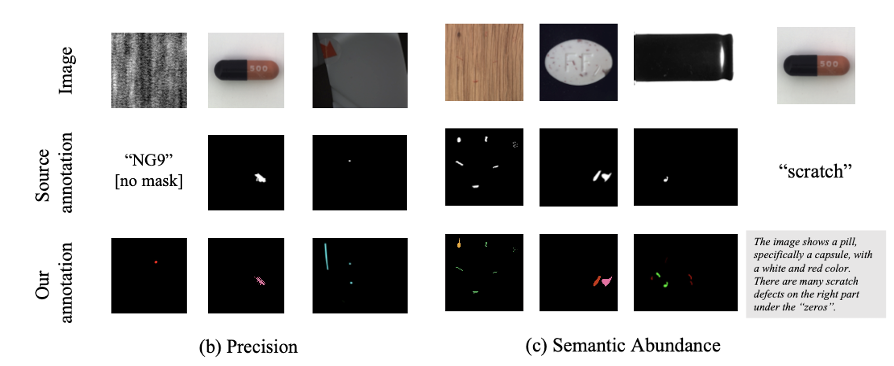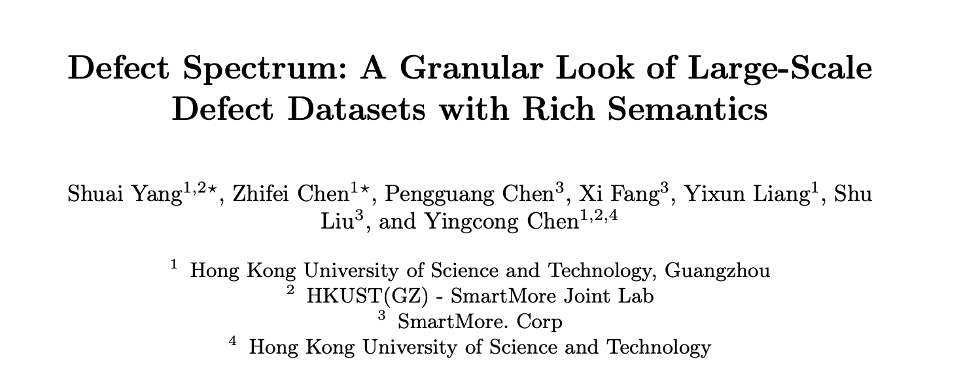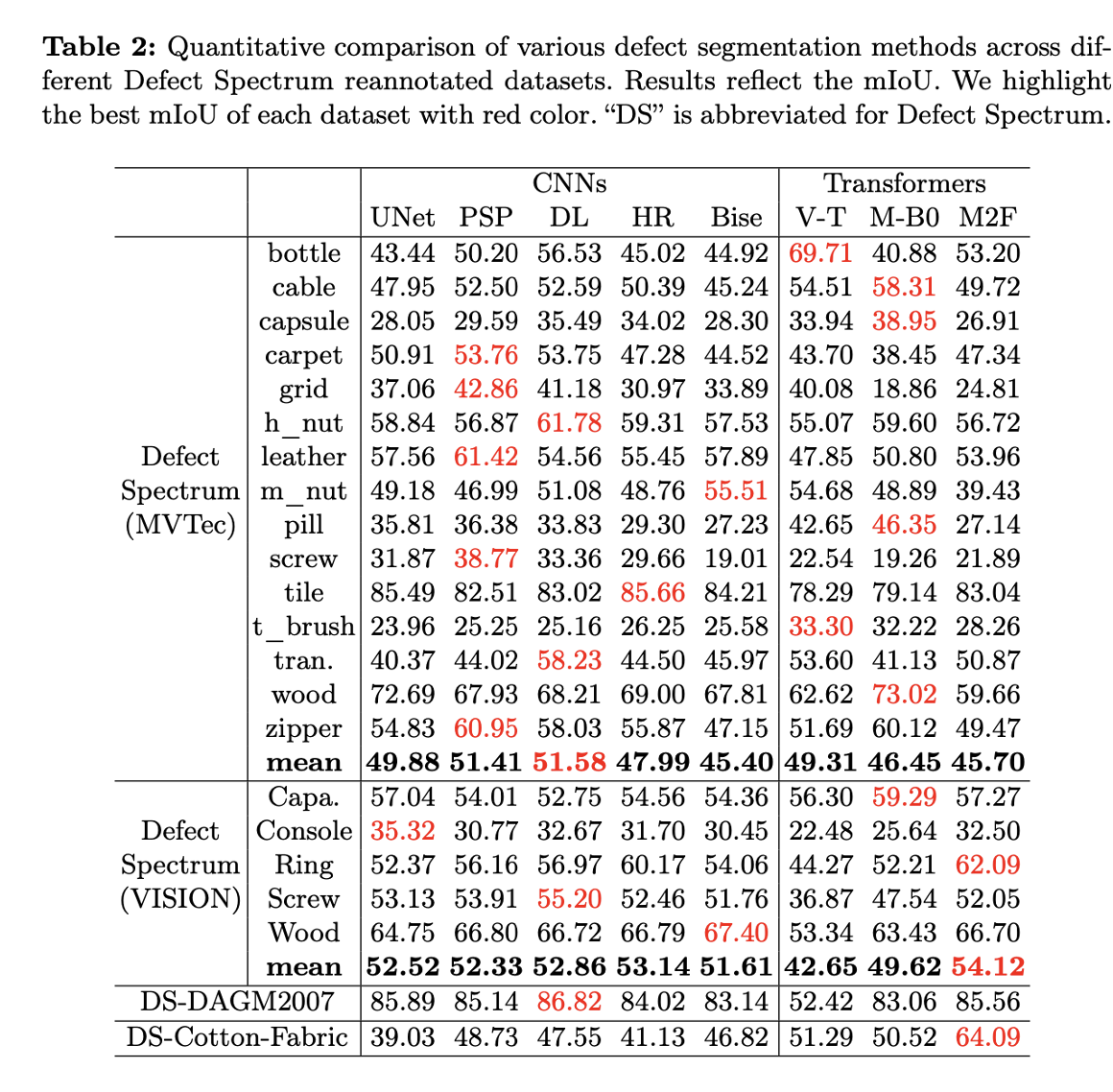突破傳統缺陷檢測的界限,\'Defect Spectrum\'首次實現超高精度豐富語意的工業缺陷檢測。
- PHPz原創
- 2024-07-26 17:38:031003瀏覽
在現代製造業中,精準的缺陷檢測不僅是確保產品品質的關鍵,更是提升生產效率的核心。然而,現有的缺陷檢測資料集常常缺乏實際應用所需的精確度和語意豐富性,導致模型無法辨識特定的缺陷類別或位置。
為了解決這個難題,由香港科技大學廣州和思謀科技組成的頂尖研究團隊,創新性地開發出了「Defect Spectrum」資料集,為工業缺陷提供了詳盡、語義豐富的大規模標註。如表一所示,相較於其他工業資料集,「Defect Spectrum」資料集提供了最多的缺陷標註(5438張缺陷樣本),最細緻的缺陷分類(125種缺陷類別),並為不同種類的缺陷都提供了像素級的細緻標籤。此外,該資料集也為每個缺陷樣本提供了精細的語言描述。具體的標註對比如圖一所示。

圖一:相較於其他工業資料集,Defect Spectrum精確度較高,標註較豐富

表一:Defect Spectrum與其他現有資料集的數量,性質對比Spectrum」基於最先進的擴散模型,推出了革命性的方法—「DefectGen」。透過利用極少量的工業缺陷資料產生影像與像素級缺陷標籤,該方法顯著提升了工業缺陷檢測模型的性能,在多個行業標準資料集上(如MVTec AD、VISION、DAGM2007及Cotton-Fabric)實現了前所未有的性能突破。
這項突破性的研究不僅大大提高了缺陷檢測的準確性,更為AI在複雜工業環境中的應用開闢了新的可能性。該專案的程式碼和模型已經全面開源。

- 論文鏈接: https://www.php.cn/link/136aa7fe7fd745073fec3fb4ef67e3b9
- 項目鏈接: https: //envision-research.github.io/Defect_Spectrum/
- Github Repo: https://github.com/EnVision-Research/Defect_Spectrum
- Dataset Repo:rumfhugging.co/datasets/Defectfrum/Defectmm
- 突破傳統的缺陷檢測限制,更貼近落地生產
圖二:實際工業生產,缺陷檢測以及分析的閉環
 在實際的工業生產中,我們對缺陷檢測的要求更加細緻,工廠需要在控制缺陷件的同時確保收益率,如圖二所示。然而,現有的缺陷檢測資料集常常缺乏實際應用所需的精確度和語義豐富性,例如一塊金屬板表面如果有較大面積的油漆剝落,儘管缺陷面積很大,但對金屬板的功能影響可能微乎其微。然而,如果金屬板內部有一條細小的裂縫,這條裂縫雖小如髮絲,卻可能在承受壓力時導致金屬板瞬間斷裂,顯著影響其性能,甚至引發嚴重的安全隱患。
在實際的工業生產中,我們對缺陷檢測的要求更加細緻,工廠需要在控制缺陷件的同時確保收益率,如圖二所示。然而,現有的缺陷檢測資料集常常缺乏實際應用所需的精確度和語義豐富性,例如一塊金屬板表面如果有較大面積的油漆剝落,儘管缺陷面積很大,但對金屬板的功能影響可能微乎其微。然而,如果金屬板內部有一條細小的裂縫,這條裂縫雖小如髮絲,卻可能在承受壓力時導致金屬板瞬間斷裂,顯著影響其性能,甚至引發嚴重的安全隱患。
更好比說,假設一件衣服的拉鍊齒出現了錯位,這種缺陷雖然看起來尺寸不大,甚至不容易被發現,但卻嚴重影響了衣物的功能,導致拉鍊無法正常使用,消費者不得不將其退回工廠進行修復。然而,如果缺陷發生在衣物的布料上,例如輕微的鉤絲或顏色略有差異,這時就需要仔細權衡其尺寸和影響。小規模的布料缺陷可以被歸類在可接受的範圍內,允許這些產品透過不同的分銷策略銷售,例如以折扣價格進行銷售,從而保持產品流通而不影響整體品質標準。
在這一切背後,"Defect Spectrum"資料集就像一個全能的偵探,洞察一切。它不僅涵蓋了廣泛的工業缺陷類型,還為每種缺陷提供了詳盡而豐富的描述。透過這個強大的工具,缺陷偵測系統能夠更精確地辨識和分類各種缺陷,不放過任何一個細節。
Imagine that on the actual production line, with the help of the "Defect Spectrum" data set, the inspection system can quickly identify this crucial defect, immediately flag it and return it to the factory for repair. At the same time, for those minor defects or color differences in the fabric, the system can judge whether it is within the acceptable range based on detailed marking of the defects, and decide whether to sell it at a discounted price. This flexible processing method not only improves product quality, but also ensures production efficiency and cost control.
Although traditional data sets such as MVTEC and AeBAD provide pixel-level annotations, they are often limited to binary masks and cannot distinguish defect types and locations in detail. The "Defect Spectrum" data set re-evaluates and refines existing defect annotations through cooperation with four major benchmarks in the industry. For example, fine scratches and dents are contoured more precisely, and missed defects are filled in with expert assistance, ensuring comprehensive and accurate annotation.
Innovative defect generation model "Defect-Gen"

Figure 3: Schematic diagram of the two-stage generation process of Defect-Gen
Faced with the problem of insufficient defect samples in the current data set, we proposed "Defect-Gen" ”, a two-stage diffusion generator. This generator improves the diversity and quality of images with a limited number of samples through two key methods: first, using patch-level modeling; second, limiting the receptive field.
Traditional diffusion models are prone to overfitting when there are few training samples. The generated results lack diversity and often just remember the training samples. Our model effectively reduces this overfitting phenomenon by reducing the data dimension and increasing the sample size.
In order to make up for the shortcomings of patch-level modeling in expressing the entire image structure, we propose a two-stage diffusion process. First, use a large receptive field model to capture the geometric structure in early steps, and then switch to a small receptive field model to generate local patches in subsequent steps. This significantly improves the diversity of the generated images while maintaining image quality. By adjusting the access points and receptive fields of both models, our model achieves a good balance between fidelity and diversity.
Through "Defect-Gen", we provide richer and more diverse training samples for industrial defect detection, promoting the development of automated inspection technology
Comprehensive evaluation and future research directions
 Table 2: Evaluation results of some defect detection networks on the Defect Spectrum data set
Table 2: Evaluation results of some defect detection networks on the Defect Spectrum data set

Table 3: Actual evaluation criteria on the Defect Spectrum data set  Table 4: Defect Spectrum’s excellent performance in the actual evaluation
Table 4: Defect Spectrum’s excellent performance in the actual evaluation
Our evaluation of the Defect Spectrum data The set was comprehensively evaluated and annotated as shown in Table 3. This experiment verified the applicability and superiority of Defect Spectrum in various industrial defect detection challenges. Table 4 shows that compared with the original data set, the model trained on our data set increased the recall rate by 10.74% and reduced the false positive rate by 33.1%. Furthermore, the construction and evaluation process of the dataset not only provides a solid research foundation, but also provides a platform for researchers in industry and academia to evaluate and develop advanced models for the complex needs of industrial defect detection.
The introduction of the Defect Spectrum data set is like a shot in the arm for industrial production. It makes the defect detection system closer to actual production needs and achieves efficient and accurate defect management. At the same time, it also provides valuable data support for future predictive maintenance. By recording the category and location of each defect, the factory can continuously optimize the production process, improve product repair methods, and ultimately achieve higher production efficiency and product quality.
Summary
We have released the Defect Spectrum dataset and the DefectGen defect generator, which provide the high accuracy and rich defect semantics required in actual industrial inspection, and solve the problem of the model being unable to identify defect categories or locations.
We conducted a comprehensive evaluation on the Defect Spectrum dataset and verified its applicability and superiority in various industrial defect detection challenges. Compared with the original dataset, the model trained on our dataset has improved The recall rate is 10.74%, which reduces the False Positive Rate by 33.1%.
Reference:
1. Bai, H., Mou, S., Likhomanenko, T., Cinbis, R.G., Tuzel, O., Huang, P., Shan, J., Shi, J., Cao, M.: Vision datasets: A benchmark for vision-based industrial inspec- tion. arXiv preprint arXiv:2306.07890 (2023)
2. Silvestre-Blanes, J., Albero-Albero, T., Miralles, I., Pérez-Llorens, R., Moreno, J.: A public fabric database for defect detection methods and results. Autex Research Journal19(4), 363–374 (2019). https://doi.org/doi:10.2478/aut-2019-0035,https://doi.org/10.2478/aut-2019-0035
3. Zhang, Z., Zhao, Z., Zhang, X., Sun, C., Chen, X.: Industrial anomaly detection with domain shift: A real-world dataset and masked multi-scale reconstruction. arXiv preprint arXiv:2304.02216 (2023)
4. Mishra, P., Verk, R., Fornasier, D., Piciarelli, C., Foresti, G.L.: VT-ADL: A vision transformer network for image anomaly detection and localization. In: 30th IEEE/IES International Symposium on Industrial Electronics (ISIE) (June 2021)
5. Incorporated, C.: Standard fabric defect glossary (2023), uRL: https : / / www . cottoninc . com / quality - products / textile - resources / fabric - defect - glossary
6. Wieler, M., Hahn, T.: Weakly supervised learning for industrial optical inspection. In: DAGM symposium in. vol. 6 (2007)
7. Tabernik, D., Šela, S., Skvarč, J., Skočaj, D.: Segmentation-based deep-learning approach for surface-defect detection. Journal of Intelligent Manufacturing31(3), 759–776 (2020)
8. Bergmann, P., Fauser, M., Sattlegger, D., Steger, C.: Mvtec ad–a comprehen- sive real-world dataset for unsupervised anomaly detection. In: Proceedings of the IEEE/CVF conference on computer vision and pattern recognition. pp. 9592–9600 (2019)
9. Zou, Y., Jeong, J., Pemula, L., Zhang, D., Dabeer, O.: Spot-the-difference self- supervised pre-training for anomaly detection and segmentation (2022)
以上是突破傳統缺陷檢測的界限,\'Defect Spectrum\'首次實現超高精度豐富語意的工業缺陷檢測。的詳細內容。更多資訊請關注PHP中文網其他相關文章!

